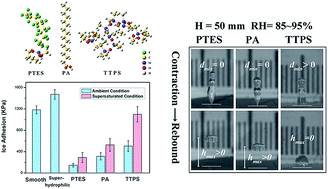Influence of different chemical modifications on the icephobic properties of superhydrophobic surfaces in a condensate environment†
Abstract
Three superhydrophobic surfaces have been prepared on an aluminium substrate, which was roughened by acid etching to form a nano-/micro-topological surface structure, and then the surface was modified by coating with a PTES (a fluorinated coupling agent), TTPS (a siloxane coupling agent) or PA (an aliphatic coupling agent) layer. Their surface wettability in terms of water contact angle (CA), sliding angle (SA) and water droplet impact dynamics was studied under different humidities at −10 °C. The reduction of ice adhesion was also investigated under both ambient and condensate environments. The results indicated that the icephobic properties of these three superhydrophobic surfaces in the sub-zero environment varied wildly. The PTES surface can maintain excellent sliding and rebounding ability of a water droplet even under extremely condensate conditions (−10 °C and relative humidity (RH) 90%), while others cannot. It is worth noting that the ice adhesion obviously increased under the condensate environment, but no apparent ice-anchoring effect was observed on any of the three superhydrophobic surfaces. In addition, a water condensing dynamic study at sub-zero temperature revealed a distinctive Leidenfrost phenomenon-like jumping behavior of condensed droplets on all three superhydrophobic surfaces with the highest jumping scale and frequency on the PTES surface. The excellent icephobic property of the PTES surface indicates that the choice of a suitable chemical modification for superhydrophobic surfaces has a significant influence on preserving water-repellency and icephobicity under extremely condensing conditions.


 Please wait while we load your content...
Please wait while we load your content...